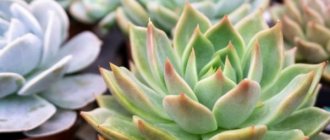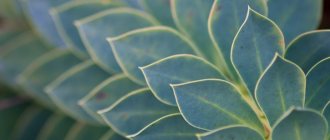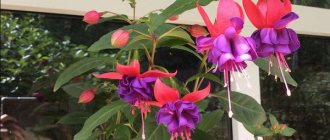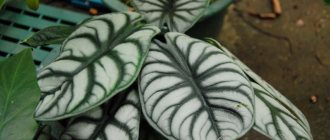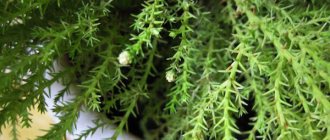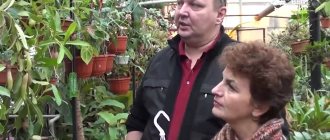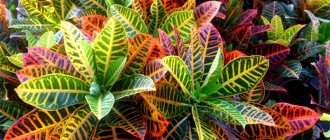Echeveria (Echeveria) or stone rose is a succulent, a representative of the large Crassulaceae family. Named after the artist Atanasio Echeverría Coda, who illustrated stories about Mexican vegetation.
This plant attracts the attention of flower lovers with its unpretentiousness and original appearance, for which it is nicknamed the stone rose. It is represented by a rosette (its diameter ranges from 3 to 40 centimeters), formed by spirally arranged fleshy leaves and resembling a rose. The surface of the leaves is covered with a waxy coating or velvety fluff that protects against moisture evaporation. The leaves can have a variety of colors: green, light green, almost white, burgundy.
In nature, echeveria grows on the plains and mountains of Mexico and Peru, where summers are very hot and winters are warm.
Typically, stone rose blooms in spring and summer, but some varieties delight with abundant and long-lasting (about a month) flowering in the winter months. Bell-shaped flowers (white-cream, lemon, yellow, coral, orange, pink, scarlet) rise on an elongated peduncle reaching 90 centimeters in height. They form inflorescences in the form of panicles or spikelets.
The stone rose in combination with other succulents looks original on an alpine hill.
Botanical description of the plant with photo
Echeveria or Echeveria is a succulent plant belonging to the Crassulaceae family.
The perennial has several distinctive features:
- may be stemless or have a stem reaching a height of 70 cm;
- some species are distinguished by creeping shoots;
- the root system is not buried, but grows superficially;
- in most species, the leaves are quite dense, hard, saturated with moisture, because of this the plant gives the impression of being made of stone;
- the leaf plates are oval in shape with a pointed tip, their length reaches 30 cm, width - 15 cm;
- the color of the leaves is quite varied: violet-pink, wine-red, gray with a blue tint, all shades of green;
- there is pubescence on the leaf blades or a coating similar to frozen wax;
- the rosette in which the leaves are collected can be dense or loose;
- The peduncle can be lateral or vertical and reach a height of up to 50 cm;
- the color of the peduncle depends on the light: in bright light it is red-orange, in dim light it is yellow;
- the flowers are small (up to 30 mm) five-membered bells, collected in erect inflorescences.
The most spectacular varieties of echeveria
We offer a selection of photos with the names of the most popular and spectacular varieties with a brief description.
- Echeveria Lau is a favorite of plant designers. A bright yellow flower against a background of blue voluminous leaves will look great surrounded by any other succulent representatives.
- Echeveria Miranda agave. The height of the stem is about 35 cm. The variety is known for a large number of cultivars with extravagant colors: from metallic to royal purple.
- Echeveria purpuzorum - a charming plump plant famous for its compactness. The largest rosette does not exceed 10 cm in diameter. It blooms for two weeks a year with red-orange inflorescences.
- Echeveria Pulidonis is a hybrid with a thinner leaf plate, the edges of which are colored reddish-brown. Capricious, absolutely cannot stand drafts.
- Echeveria Chihuahuiensis, a succulent with a funny name, is extremely demanding. Requires the creation and maintenance of comfortable conditions. With a lack of lighting, it can completely lose its varietal characteristics.
- Echeveria Nuremberg. Second title: The Pearl of Nuremberg. It is famous for its long – about a month – flowering period. Flowers of mauve color, located along the entire peduncle and a stem with a rosette at the end, create a spectacular miniature. Recommended for growing in pots.
Indoor varieties of echeveria
Of the 200 existing species of echeveria, a sufficient portion of them grow well at home. Most Popular:
- agave;
- hump-flowered;
- The Pearl of Nuremberg;
- bristly;
- Lau et al.
They all differ in botanical characteristics and color, so many gardeners prefer to grow several varieties at the same time.
Find more information about varieties and hybrid varieties of the plant here.
Main types
Over 150 species of echeveria are known. Based on them, breeders have created many varieties and varieties. Let's look at the description of the most common ones.
Graceful
This species is most often grown by gardeners. The thick stem first grows upward, but gradually lies to one side and often takes root. The plant produces many daughter rosettes, which is why it received the nickname “hens with chicks.” The leaves are pointed, emerald with a silver-blue coating, the edges are translucent.
Brilliant
The bluish (almost white) leaves are elongated, the edges are wavy. The rosettes are round. Blooms in late winter - early spring.
Gray
This plant attracts the attention of others with its unusual foliage color (it resembles a spoon in shape) - gray-blue with a pink border. The flowers have an orange tint.
White-haired
The lanceolate leaves are covered with many white hairs and have a brown border along the edges.
Agave
The flower is quite often found on the windowsills of plant lovers. A characteristic feature is star-shaped rosettes and lettuce leaves with a scarlet edge. There is no stem or it is very short. The flowers are yellow-pink and appear in late autumn.
Agave echeveria has several varieties.
Miranda
The rosettes (there are several on one stem) of this hybrid look like a lotus. They look very impressive, as the leaves can have a variety of colors - silver, yellow, pink, scarlet, blue, lilac, purple. Flowers bloom in late autumn or early winter.
Taurus
With age, the foliage acquires an increasingly rich burgundy-purple color.
Romeo
The color of the leaves varies significantly - from orange-red to variegated.
Darenberg
A distinctive feature is the many lateral rosettes located on elongated stems. Green leaves have a red rim and are covered with a blue coating.
hump-flowered
The gray-green leaves have a pointed tip and wavy edges. Their surface is covered with growths. This species has many varieties.
Pearl of Nuremberg
Hybrid with pinkish-gray foliage. Does not bloom at home.
Metallica
The leaves are reddish on the outside and yellow on the inside, with a metallic tint.
Magic Red
A distinctive feature is the bright red leaves. The rosette looks like an open flower.
Black Prince
A characteristic feature is brown (almost black) leaves with a greenish tint. The rosette is loose. The flowers are orange or red-chocolate. They bloom in November-December.
In the summer, the Black Prince is the most demanding of light among its relatives. In winter (after flowering) it needs complete rest.
Tongue-like
The light green leaves are shaped like tongues. Straw-colored flowers. They appear mainly in spring, and sometimes in the middle of winter.
Lau
The rosette is large and loose, with a small number of leaves. An abundant waxy coating gives the leaves a smoky tint and a special decorative effect. A distinctive feature is the large (up to two centimeters in diameter) “porcelain” flowers.
Echeveria Lau is the most whimsical among the representatives of the genus.
bristly
The rosettes are covered with thick pile. They have a spherical shape and consist of many dark olive leaves. Similar to a chrysanthemum flower.
Desmeta
The leaves have a bluish tint. The flowers are yellowish-orange. The shoot gradually lengthens and becomes creeping. Therefore, the plant is often grown as an ampel plant.
Poulidonis
The stem is missing. The elongated leaves are bluish, with scarlet edges. The rosette resembles a star in shape.
Nodular, or Nodulose
Red stripes run along the upper side of the green leaves, and red spots are “scattered” along the lower side.
Shaviana, or Sho
The purple leaves (they are not as fleshy as those of their relatives) have a silvery tint and wavy edges with a pinkish rim. The rosette looks like a head of cauliflower.
Echeveria Sho loses almost all its leaves in winter.
Temperature
Echeveria is a heat-loving plant that thrives even in very hot conditions. During its growth period, room temperature is recommended. Since the flower loves daily temperature changes, the appropriate indicator for it in the daytime is from +22 to +26 °C, at night - from +10 to +16 °C.
In winter, the air temperature in the room with echeveria should be no higher than +13 °C and no lower than +7 °C.
Wintering in cool and dry conditions will have a beneficial effect on bud formation. Otherwise, the absence of a dormant period will significantly weaken the plant.
Features of plant flowering
Echeveria - species: agave, Pulidonis, Black Prince, Purpuzorum, Lilacina
Some hybrids require special conditions, otherwise they will not bloom.
Important! Echeverias in mixes (small size) are usually used to create flower ensembles.
Blooming succulent
Period of activity and rest
In the spring and summer months, echeveria blooms for 14-30 days. In winter, most of the representatives of the genus retire. At this time, the regime is seriously changed: the temperature is reduced to 8-15 ℃ and irrigation is reduced to one procedure per month.
Types and shape of flowers
Small buds are located in inflorescences located on a vertical lateral peduncle. The tone of the petals depends on the lighting conditions:
- lack of sun causes yellowness;
- a sufficient amount - a reddish or orange tint.
At the end of the budding period, babies are formed on the peduncles.
How often and correctly to water?
Echeveria tolerates drought conditions well and does not like even slight waterlogging of the soil. Therefore, watering is permissible only after the earthen clod has thoroughly dried to 1/3 of its depth. Excess moisture that appears in the pan is immediately removed.
Recommended frequency:
- in spring and summer – once a week;
- in autumn and winter - once a month.
For irrigation, use well-settled or rainwater.
To avoid moisture getting on the leaves, leading to rotting, this procedure is carried out using a watering can with an elongated spout.
Caring for echeveria at home. Details
Echeveria agave.
Photo Caring for echeveria indoors is simple and not burdensome. The main condition is to take care of the plant due to its fragile leaves with a thin protective shell, which is very easy to damage. Therefore, it is better to minimize any contact with the flower.
Bloom
Most echeveria bloom for 2-4 weeks in spring and summer .
The rosette produces a long (up to 70 cm) lateral or vertical peduncle with small bell-like flowers collected in inflorescences. The color of the petals depends on the level of illumination: in dim light - yellow, in bright light - orange or red. After flowering, babies may form at the end of the peduncle.
Temperature
The plant loves warmth. The optimal temperature for it in summer is 20-27 degrees, in winter – 10-15 degrees, but not lower than 6. For species that bloom in winter, the temperature should be maintained at 18-20 degrees.
The leaves of the plant are very sensitive to cold and frost; under their influence, the rosette significantly worsens its appearance.
Therefore, it is important to protect the stone rose from frosty air when ventilating in winter.
Spraying
Indoor echeveria prefers low air humidity and feels great even next to operating heating devices. Therefore, there is no need for spraying or any other air humidification.
Lighting
Being a native of deserts and semi-deserts, she needs bright lighting; she is not afraid of even direct sunlight. The best place is a window sill facing south or southeast .
The plant can tolerate light shading, but in this case the rosette will stretch in height. In summer, it is recommended to take it out into the fresh air: onto the balcony or into the garden, taking care to protect it from rain and wind.
Watering
Being a succulent, echeveria needs moderate and even scanty watering.
In summer, the soil is moistened approximately once a week after the top layer of soil in the pot has dried out by 3-5 cm. In winter, watering is reduced to once a month. When moistening, it is important to avoid getting water on the leaves and especially inside the rosette - this can lead to rotting. After watering, pour out the remaining water in the pan. The rule applies: it is better not to top up than to overfill.
For irrigation, settled or rainwater at room temperature is used..
Pot
Since echeveria has a shallow root system, it needs a wide but shallow pot. It is optimal that its diameter is 1.5-2 cm larger than the diameter of the plant. It is imperative to have drainage holes, otherwise the roots will begin to rot as a result of stagnant moisture.
Priming
Homemade echeveria needs loose, low-nutrient soil with a neutral reaction based on sand.
Store-bought substrate for succulents is perfect. If you have the opportunity to prepare the mixture yourself, you can choose one of the options:
- 2 parts sand, one part each of leaf and turf soil;
- 2 parts coarse sand, 1 part peat, 1 part loamy soil.
To prevent root rot, you can add a little crushed charcoal to the mixture.
It is necessary to lay a layer of drainage at the bottom, which would occupy 1/3 of the pot. You can use pebbles, expanded clay, broken bricks, and clay shards as it.
Feeding and fertilizer
Echeveria does not need frequent feeding. It is enough to feed it once a month during the growing season (spring and summer) with complex fertilizer for succulents (cacti) in half the dosage.
Excess minerals can damage the plant's delicate root system.
Transfer
It is better to transplant echeveria in the spring, at which time it will more easily withstand stress and resume growth faster.
Young specimens are replanted annually, adults - as needed, every 3-4 years. They are advised to change the top layer of soil every spring.
Replanting is carried out very carefully to minimize damage to the fragile root system and leaves.
Watering before replanting should be reduced in order to replant the flower with a dry clod of soil.
Trimming
The flower does not require shaping or other special pruning. Dried lower leaves are periodically removed to preserve the decorative appearance of the plant.
If after winter the rosette has become too elongated, you can cut off the top, leaving a “stump” 3-4 cm high. This way the echeveria will rejuvenate and new shoots will begin to grow.
Rest period
Most species are dormant in winter. At this time, the plant should be kept in good light and a temperature of 8-15 degrees. Watering is reduced to 1 time per month.
Is it possible to leave without care during the holidays?
Echeveria is a very hardy plant. By placing it on a brightly lit windowsill and moderately moistening the soil, you can safely leave for 2-3 weeks without worrying about the well-being of the flower.
What kind of pot is needed to grow a flower?
The container for planting echeveria should be 1.5-2 cm larger than the diameter of the plant itself and have drainage holes. Due to the shallow root system, a low and at the same time wide pot would be an ideal option.
Experienced flower growers recommend purchasing ceramic or clay containers that allow moisture and air to pass through perfectly. When giving preference to plastic products, it is worth remembering their ability to heat up quickly, which negatively affects the condition of the root system.
Types and varieties of echeveria for indoor floriculture
Many types of echeveria are suitable for home breeding. Let's look at the most popular of them.
Agave (agavoides)
A bushy succulent with virtually no stem. It has a spherical rosette consisting of fleshy leaves 9 cm long. They are triangular at the base, the apices are rounded, and the surface is waxy. The leaf color is light green at the bottom, transitioning to carmine red towards the top. From late spring and throughout the summer, many red-yellow flowers bloom from the apical axils of the leaves.
Derenberg (derenbergii)
A species in which shoots creep. The leaf rosettes are almost cylindrical in shape, similar to spruce cones. The leaves are spatulate, with pointed tips, about 3-4 cm long. From the base, most of the leaf blade is light green, towards the edge it is reddish-brown. It blooms in April - June with orange flowers located on short peduncles of 3-5 pieces.
Elegant
A stemless succulent plant with a sessile central rosette and vertically growing lateral rosettes. The leaves are obovate, with pointed ends, curving towards the center, 5-6 cm long. The surface is light green, with a characteristic silvery coating. Long peduncles with yellow inflorescences bloom from the apical axils in June and May.
Bristly (setosa)
A bushy succulent with or without a short stem. The leaf rosettes are spherical and dense. The leaves are dark green, lanceolate, with a triangular apex 7-9 cm long. The entire surface of the leaves is covered with white bristly spines. At the end of spring, the plant begins to bloom profusely with small, pubescent red-yellow flowers, which are located on tall peduncles 30 cm long.
Pillow-shaped (pulvinata)
Low shrub with loose rosettes. The leaves are fleshy, elongated, about 5 cm long, up to 1 cm thick. The surface of the leaves is light green, there is a slight redness on the edge. Covered with white, thick pile. The flowers are red-orange, located on powerful peduncles.
Lau (laui)
A stemless species with a wide rosette up to 20 cm. The leaves are broadly oval, almost round, 6 cm long. Their surface is covered with a thick waxy coating, which is why the rosette acquires a light gray tint. The flowers are large, red-orange, and also richly covered with wax.
Priming
Echeveria prefers loose soils with little nutritional value. For planting, you can purchase an industrial composition for succulents or prepare the substrate yourself.
It is recommended to add fine brick chips and river sand to store-bought soil, and crushed charcoal to prevent root rot.
To prepare your own substrate you will need:
- turf soil - 1 part;
- dry clay – 1 part;
- coarse sand – 1 part;
- leaf soil - 2 parts;
- drainage.
Origin story
This succulent is native to Mexico. It is also found in the United States and Peru; some species were found in the Caucasus mountains.
Echeveria was first mentioned in scientific works in the 19th century . However, by that time the plant had long spread throughout the world thanks to trade relations. The stone rose was grown in the palaces and gardens of wealthy aristocrats, it was added to the bouquets of court ladies, and used as decoration for dresses, hats, carriages, and so on.
Transplantation after purchase and more
Young plants (under 3 years of age) are replanted once a year, and subsequently once every 3-4 years. The optimal time for this event is spring.
The process includes several stages:
- Place a layer of drainage at the bottom of the prepared container; for this purpose, you can use broken brick, expanded clay or crushed clay shards.
- Fill the drainage layer with substrate and place the flower in the center of the pot.
- Sprinkle fresh soil around the perimeter of the plant, using your fingers to remove any air pockets that form.
- At the final stage, surround the root collar of the echeveria with small pebbles or a layer of coarse river sand to improve the outflow of moisture.
Leave the transplanted plant for 7-10 days in a shaded place.
Care
After moving a plant to a new location, it requires normal care.
- Humidity and temperature. The flower is well adapted to dry air and hot heating season. But still, in order to avoid damage to the waxy coating on the leaves, the flower cannot be sprayed. The comfortable temperature for the plant in the hot summer is +25, and in winter it feels good at +18.
- Lighting. Echeveria loves the influence of direct sunlight and this differs from many house plants. They do not cause any harm to the leaves at all. It is recommended to place the flower pot in the southern sector. If you place it on the balcony, then remember that the flower should be protected from rain.
- Watering. Echeveria is picky about this process. If there is excess moisture, rotting occurs. In this regard, the flower needs good drainage. If there is not enough moisture, the leaves become limp and take on a wrinkled appearance.
- Feeding. The application of any fertilizers is not recommended. This may harm the appearance of the flower. The permissible period for feeding is the growing season. In winter, this is strictly prohibited.
Reproduction
In indoor conditions, echeveria can be propagated in almost all available ways.
Sowing seeds
The process of growing from seeds is considered the longest, as it takes up to 3 months.
Seeds for sowing can be purchased at the store or collected yourself. They are scattered over the surface of a flat container filled with a mixture of peat and sand (1:1), lightly pressed down and moistened with a spray bottle. Cover the top with plastic film or glass.
For 15-20 days it is necessary to maintain temperatures of about 25 degrees. When the seeds germinate, the film is removed. The seedlings are transplanted after 2-3 months.
Leaf
Algorithm of actions:
- Cut off a healthy leaf.
- Dry: 14-20 days for a fleshy plate, 2-3 hours for a thin specimen.
- Press the sheet with the cut inward onto the prepared soil.
- Moisten with a spray bottle and cover with film.
- Maintain the temperature in the greenhouse at +25 °C.
As a rule, when breeding using this technology, babies appear in 2-3 weeks.
Rosettes
This method is considered the most effective - echeveria throws out the first flower stalks within a year. Replanting a rooted rosette is recommended after 2 months, or within a year in case of slow plant growth. The algorithm of actions is the same as when rooting a leaf.
How to root with the top?
Typically, rooting with apical cuttings is carried out after the lower leaves have completely fallen off, as a result of which the plant becomes inconspicuous. The planting method is identical to leaf planting. When propagated in this way, the cuttings buried in the soil begin to grow in about 20 days.
How does echeveria reproduce?
Echeveria - care and propagation at home
If echeveria is easy to care for, then with reproduction the situation is somewhat different.
Sprouted babies for propagation of echeveria
This process is complex, but try different methods to get the final result. The flower can be propagated by sowing seeds or rooting cuttings.
Germination of seeds
Propagating echeveria by seeds is extremely difficult, and this method is not chosen very often. Before collecting the seeds, you need to wait for the plant to bloom, and getting this succulent to produce inflorescences is extremely difficult.
Pollination is carried out manually. After this, you need to wait until the plant blooms and produces seeds. When the material is received, it needs to be sown in a substrate with slightly increased acidity. After such painstaking and lengthy preparation, planting echeveria seeds is quite simple.
Important! The seeds are planted so that they are not covered by soil. Planting material must remain on the surface.
Containers with plantings should be placed in a warm place where the air temperature varies from 25 to 30 degrees Celsius. Air humidity should also be high. The complexity of the process does not always justify itself, and often it is simply impossible to grow sprouts.
Rooting cuttings
The flower has a period when the lower leaves dry out and fall off by themselves, and the upper ones begin to bloom. As a result, the top very soon bends to one side from the weight of young and massive leaves. At this point, the appearance of the echeveria becomes not entirely attractive, and therefore it needs a haircut. The top is simply cut off, after which it needs to create conditions under which it can take root.
Important! Rooting cuttings requires high humidity and warmth.
Reproduction by rosettes
Propagating this plant with leaves is also not easy. In order for the leaf to take root, you need to create the necessary conditions. Propagation by seeds and rosettes is equally difficult.
A specimen of Echeveria Carnicolor
The most difficult thing is maintaining the desired temperature and high humidity. Such an atmosphere should be maintained in a small but voluminous space.
Diseases and pests
Ignoring the rules of agricultural technology can cause the development of the following diseases:
- dry rot;
- root rot;
- powdery mildew.
When the first signs of disease are detected, the plant is treated with a fungicide.
Echeveria is susceptible to attacks from pests such as:
- root-knot nematode;
- root mealybug;
- mealybug.
To combat harmful insects, the flower is treated with an insecticide.
Description and characteristics
Names: what are they called and why?
The genus was named after the Mexican artist Atanasio Echeverría y Godoy, who illustrated books on the flora of Mexico and was the first to describe an exotic plant with fleshy, dense leaves collected in a rosette. Therefore, abroad the plant is called “echeveria”, after the artist’s surname, but in Russia and the CIS countries they use the more familiar version “echeveria”. The leaf plates of the plant are so saturated with moisture that they are as hard as stone, which is why echeveria is popularly called “stone flower” and “stone rose”.
Sometimes echeveria is called “juvenile” because of its external resemblance to the plant of the same name, but these are two different flowers, the differences of which will be discussed below in the corresponding section.
Botanical characteristics
| Domain | Eukaryotes |
| Kingdom | Plants |
| Department | Flowering |
| Class | Dicotyledons |
| Order | Saxifragaceae |
| Family | Crassulaceae |
| Genus | Echeveria (echeveria) |
| Prevalence | Mexico, USA (from Texas to California), Southern Peru, Caucasus Mountains. |
Possible problems
Often the poor condition of echeveria is caused by non-compliance with the watering regime or improper lighting.
What to do if you are stretched out?
Stretching of a flower indicates a lack of sunlight. The problem can easily be eliminated by moving the pot to a more illuminated place.
Why did you lower the leaves down?
Drooping leaves that have lost their original elasticity indicate dehydration of the soil. In this case, the substrate must be moistened by adding liquid complex fertilizer to the water, and then strictly adhere to the watering regime.
Also, the reason for drooping leaves may be low room temperature or stagnation of water in the root system.
The lower plates fall off and turn yellow
Yellowing and falling of leaves is associated with stagnation of water in the pot. To eliminate the problem, it is recommended to completely replace the soil.
The socket is rotting: how to save it?
If the socket rots, first of all you need to give it a chance to dry. In the future, it is recommended to transplant the plant into another soil, cutting off the damaged lower leaves and fragments of the root system.
Interesting to know
You may not know the following about Echeveria:
- In its homeland it is called a stone rose. Among the names of the flower there are also “hare cabbage” and “tenacious”.
- Echeveria is often confused with another plant called "juvenile". Both species belong to the same genus, but the juvenile has a thinner and lighter leaf blade, is more resistant to low temperatures and reproduces using tendrils with daughter rosettes. Echeveria is thermophilic, does not tolerate a lack of light, and its children are formed at the base of the stem.
- The plant itself has neutral energy, but if you surround it with care, you will be guaranteed a cozy atmosphere.
- According to psychics, echeveria is a talisman. It protects the owner and his house from black magic.
- The succulent has medicinal properties. At home, it was used as a remedy for kidney diseases, bronchitis, and colds. Since ancient times, an infusion of echeveria leaves has been taken as a sedative.
Growing echeveria is an interesting activity for both beginners and professionals. The only difference is that experienced gardeners can experiment with the plant more confidently, planting it as part of a flower arrangement. Follow the minimum care requirements, and your home will be decorated with an exotic beauty for a long time.
How to create a mix composition?
The process of creating a composition with echeveria includes several manipulations:
- Choose a suitable container.
- Lay out in successive layers:
- drainage expanded clay;
- soil diluted with vermiculite/perlite;
- moss.
- Arrange the succulent cuttings so that there is room for further growth.
- Lay out decorative elements: pebbles, shells, figurines, etc.
- Water without allowing water to get on the leaves of the plant.
When creating a mix composition, it is important to use succulents with similar habitat requirements.
Echeveria in the florarium
Echeveria looks good in a florarium - a small greenhouse for ornamental plants. It creates a desert or semi-desert landscape similar to the original one, where the succulent lives. For cultivation, a mix of different varieties of echeveria is collected or combined with other plants that are similar in care:
- lithops,
- haworthia,
- Crassula,
- Kalanchoe,
- cacti,
- young
To make a florarium, take a glass container and treat the inside with alcohol. A drainage layer is filled to a quarter of the height, and disinfected soil is filled the same amount. Prepared succulents are planted in a florarium, and the free space is decorated.
Tip Decorate the composition with colored sand, moss, bark, decorative stones, glass and shells.
Water the plants using a small watering can and in smaller volumes than succulents growing in pots. Over time, the flower arrangement will outgrow its container, and everything will have to be transplanted into a larger florarium.
Signs and superstitions
In ancient Rome, it was believed that echeveria protected against black magic and the evil eye. In the Middle Ages, this plant was planted on the roofs of houses to ward off lightning and thunder.
Thanks to the unpretentiousness of the stone flower, people believed that echeveria was an excellent talisman against sorcerers and witches. In Rus' they believed that if a person is constantly near this plant, then his body is saturated with vitality and energy.
Sometimes echeveria was planted on graves to help the deceased cleanse himself and continue his journey to heaven. Because of this, for some time the plant was no longer grown in houses and flower beds. Now the stone rose is considered an assistant in cleansing space and attracting positive emotions. Many florists use echeveria when making wedding bouquets, believing that it will bring happiness and love into the bride's life.
Transfer
It will most easily withstand the stress of replanting in the spring, growth will quickly resume, and flowering will occur in due time. For the first two to three years, the plant is replanted annually, then every three to four years, but observing the rule of annual replacement of the top layer of soil.
When necessary, desirable and undesirable
An adult plant is transplanted if the echeveria grows and becomes crowded in its original pot. You cannot replant a flower during periods of flowering or dormancy, as well as during the cold season . Sometimes transplantation is carried out in order to cure the plant from fungal diseases.
Requirements for soil and pot
The pot is chosen a little larger than it was before, made of clay or ceramic, with holes for draining water. A drainage layer is poured below (pebbles, expanded clay, brick chips), loose soil is selected, with the addition of sand (according to the recipes given above), or using purchased soil for cacti and succulents.
Step-by-step instruction
The transplant process is simple:
- Prepare the pot, add drainage and soil.
- Make a small depression in the soil (no more than 2-3 cm in depth), slightly larger in size than the root system of the flower.
- Remove the echeveria from the old pot. Be careful not to damage the rosette or roots.
- If the plant is sick, carefully clean the roots from the old soil. Healthy echeveria is transplanted with a dry clod of earth. To do this, reduce watering before transplanting.
- Place the echeveria in the hole, sprinkle the roots with soil and press it lightly with the palm of your hand.
- Water the flower through the tray, let the roots soak in moisture and drain off excess water, and then put the pot back in its original place.
